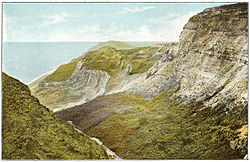Blackgang Chine


Blackgang Chine was a coastal ravine on the south coast of the Isle of Wight, in Hampshire: the term for such a ravine on the coasts of Hampshire and Dorset is a 'chine'. The chine itself is now destroyed but it has given its name to the oldest amusement park in the United Kingdom.
The chine cut through the soft Cretaceous cliffs along the island's southern coast about six miles from Ventnor, at the southern tip of the Isle of Wight, just below St Catherine's Down.
The amusement park is owned by the Dabell family and has a sister park named 'Robin Hill'. Blackgang Chine is home to life-sized Pirate Ships, Fairy Villages and Castles, Dodo Valleys, and the original Cowboy Town. Owing to the unstable land on which the park is situated, landslides occur frequently, meaning that attractions have continually to be moved further inland to safer ground.
History
During Blackgang Chine's early years, the area was a steep gaunt ravine, overlooking Chale Bay, stretching around three-quarters of a mile down to the shore. It was a quiet place, visited by few people other than local fishermen with rumours of a thriving smuggling trade, which has now become a key theme of the park.[1]
On 11 October 1836, the cargo ship Clarendon was wrecked at the foot of Blackgang Chine, with the loss of all aboard.[2]
During the Victorian period, the fashion grew for seeking out new healthy holiday resorts, ideally near the coast. Hampshire was an early recipient of the new Victorian railway network and is great island, the Isle of Wight, became an increasingly attractive holiday destination. Alexander Dabell, the founder of the park, soon realised the business potential of this, trying various ventures. In 1839 Alexander became friends with a publican who had recently built a hotel at Blackgang, which now forms the Chine Café (Formerly Pirates' Pantry restaurant) and administration offices.
After studying the gault and chine gorge, he knew instantly that gardens could be set up that would appeal to the Victorians as a romantic holiday destination. This along with the increasing popularity of the adjacent Sandrock Spring (a Chalybeate spring) led to Alexander concluding a lease for the site in 1842 and the establishment of Blackgang Chine amusement park in 1843. The area was then opened up to the public with pathways built down to the ravine and gardens landscaped on the cliffs. Steps were built to give access to the beach from the lower road. Since the park was opened, it has remained a family business, with the descendants of Alexander Dabell owning it ever since.[3][4]
The park's establishment in 1843 allegedly makes it the oldest theme park in the UK. Its initial theme of a general-purpose scenic and curiosity park led to one of its most famous attractions, a large whale skeleton, which had been washed up near the coast of The Needles in 1842, and is still a showpiece today.
The chine today
Owing to continual landslides, the chine itself has been destroyed. However, coastal erosion still has a significant impact on the area today. The park's focus now is themed entertainment for families with young children, lifesize animatronic dinosaurs being a noted feature. The same owners run a sister site, the Robin Hill countryside adventure park.[5] Clifftop walks in and around the area give panoramic views of the English Channel and the south-western Wight coast.
Geology

Sited below the village of Blackgang at the western end of the Undercliff, Blackgang Chine was, historically, a spectacular ravine (in 1800 a "steep gaunt ravine" descending 500 feet over about three-quarters of a mile).[1]
The location is based on unstable terrain owing to the underlying Gault Clay strata, resulting in a succession of huge landslips giving the area a very rugged appearance akin to the better known Jurassic Coast.[6] Currently the cliffs are eroding at a rate of about 11 feet a year, although this process is not gradual. Large areas of land tend to collapse in stages after periods of heavy rain. The areas most recent and destructive cliff falls occurred in 1928, 1961 and 1994.[7] Continuing landslides and coastal erosion swept away the paths in the early 1900s, and have since obliterated the chine itself and repeatedly forced the park owners to move the clifftop facilities inland.[3]
Outside links
| ("Wikimedia Commons" has material about Blackgang Chine) |
- Location map: 50°35’20"N, 1°18’52"W
- Blackgang Chine
- Audio and Video Clips from the fantasy park
- Old pictures of Blackgang Chine
- Blackgang Chine discussion
- Far From the Sodding Crowd (Film)
References
- ↑ 1.0 1.1 Blackgang Chine
- ↑ Owen Gladdon's Wanderings in the Isle of Wight, "Old Humphrey", E.Stevenson & F.A.Owen, 1855 Google Books retrieved 5 July 2008)
- ↑ 3.0 3.1 A Walker's Guide to the Isle of Wight, Martin Collins, Norman Birch, Cicerone Press, 2000, ISBN 1-85284-221-0 (Google Books, retrieved 9 July 2008)
- ↑ May 2000 report, Isle of Wight Postcard Club (retrieved from Internet Archive, 5 July 2008)
- ↑ Coaster Force - Blackgang Chine
- ↑ World Heritage / Geopark Study, Isle of Wight Centre for the Coastal Environment, www.coastalwight.gov.uk
- ↑ Blackgang Chine Theme Park - The battle against erosion (invectis.co.uk)